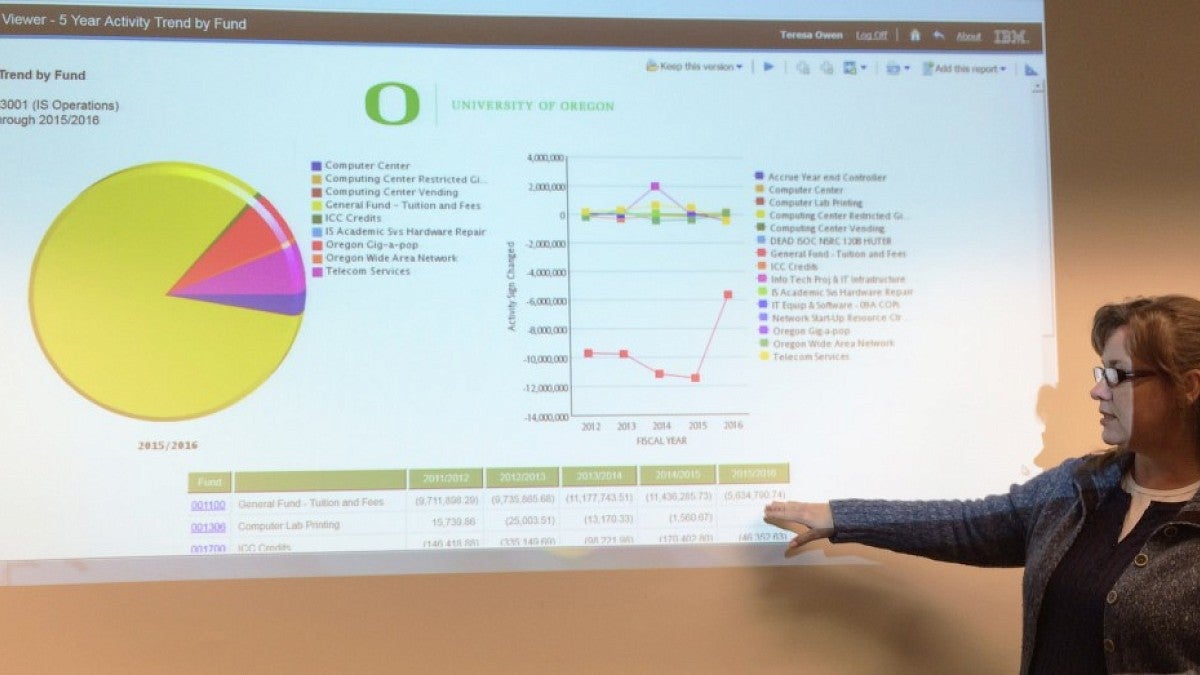UO staff who work with data involving students now have access to that information through Integrated Data and Reporting, a web-based UO service that provides a powerful, integrated approach to campus data analysis and reporting.
The Integrated Data and Reporting tool, known by the acronym IDR, offers access to university data — about finances, human resources, and, now, students — in formats that are intuitive to read, such as lists, graphical charts and spreadsheets.
"IDR makes it much more efficient for people to get their work done," said Jim Blick, the UO's assistant registrar for statistics, reporting and analysis.
The new reports available to approved users include class rosters, lists of undergraduate majors, and departmental class schedules. The tool carries the same restrictions on access to student data that apply to all university activities.
Since data and reports about students were launched Oct. 20, the number of people using IDR has increased by more than 10 percent, to more than 350.
"We have had really heavy demand for the tool," said Sue Eveland, the university registrar and assistant vice president for enrollment management, adding that new training sessions are being offered to accommodate the rush of new users. "People are very excited about it."
Student data is the last of three major categories of university data to be added to IDR. Users have had access to UO finance data since December 2012, and HR data was added in October 2014.
IDR offers many benefits over the existing data "warehouses." It adds convenience for typical users while also offering more advanced capabilities for power users.
For one thing, IDR is much more report-focused.
IDR users can use a standard set of reports rather than having to write their own queries to get the right data. And the number of standard reports will grow over time.
If departments need reports that don't yet exist, they can create them. Leeann Ford, the business manager for Information Services, said, "The (IDR) report writer license allows me to create custom reports for specific needs without having to consume expensive programmer time."
Jim Blick, the UO’s assistant registrar, adds that IDR enables much easier sharing of information. "You can schedule the report to run at a certain time and have it emailed to you or to somebody else," he said.
Other benefits of IDR include chart-of-accounts reports that are updated daily and cleaner transaction detail reports.
For power users, IDR provides access to far more information than the older data warehouses offer.
"With the (IDR) report writer license I have, I've been able to get a much broader view into what sort of data is available," Ford said.
Significantly, IDR adds the ability to run reports that combine data from all three areas — students, finance and HR. That can be difficult in the older data warehouses, which keep the three data categories separated.
Plans for future improvements to IDR include adding additional analytical features, reports and dashboards.
Information Services, UO's central information technology unit, worked with the IDR Steering Committee (http://idr.uoregon.edu/committees/steering) and other partners across campus to develop IDR as a replacement for the three older data warehouses containing student, finance and HR data.
Those data warehouses continue to run in parallel to IDR. The steering committee is developing a plan to sunset them in the future, once equivalent functions are available in IDR, but no dates have been set.
The IDR service is available for both academic and administrative units. Training is also available. UO employees who need access to student, finance or HR data in IDR should visit http://idr.uoregon.edu/getting-access.
To see lists of available reports, visit http://idr.uoregon.edu/reports and select a report type.
Learn more about IDR at http://idr.uoregon.edu. Questions can be sent to idr@ithelp.uoregon.edu.
—Nancy Novitski, Information Services


